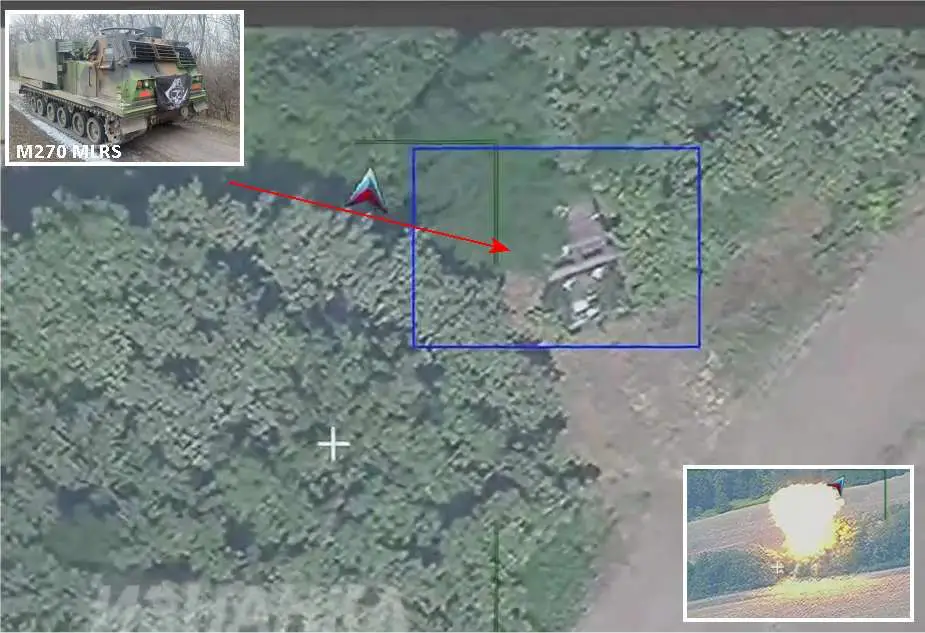Breaking News
Russia Claims First Destruction of Ukrainian M270 ATACMS Missile Launcher with Iskander-M Missile.
Russian forces have reportedly destroyed the first Ukrainian M270 Multiple Launch Rocket System (MLRS) using an Iskander-M mobile ballistic missile near the town of Bezdryk in the Sumy region. The M270 was allegedly targeted while supporting Ukrainian military operations in the Kursk region. This incident, if confirmed, would mark the first loss of an M270 system in Ukraine's ongoing conflict with Russia.
Follow Army Recognition on Google News at this link

A video published on Social Network shows the destruction of one M270 MLRS rocket/missile launcher of Ukrainian army. (Picture source: Social Network)
According to open-source information, Ukraine has received a total of 34 M270 Multiple Launch Rocket Systems (MLRS) from Western allies. The United Kingdom delivered 14 M270B1 units, with Norway contributing 11 M270 units. Germany provided five M270 "MARS" systems, and Italy delivered two M270A1 as well as France. These systems, delivered between July and October 2022, have significantly enhanced Ukraine's ability to conduct precision strikes against Russian targets..
The M270 Multiple Launch Rocket System (MLRS) is a rocket/missile artillery launcher vehicle developed by the United States and has been in service with various countries since the early 1980s. It plays a crucial role in providing long-range fire support for ground forces. The M270 is mounted on a tracked vehicle chassis, which gives it significant mobility across various terrains, including rugged and off-road environments. This mobility allows the system to be quickly deployed and repositioned as needed during military operations, making it a flexible and responsive asset on the battlefield.
The M270 can carry and fire twelve 227mm rockets or two Army Tactical Missile System (ATACMS) missiles. These rockets and missiles can be fitted with different types of warheads, including high-explosive, cluster munitions, or guided munitions like the Guided Multiple Launch Rocket System (GMLRS). The range of the 227mm rockets varies depending on the type of munition, with unguided rockets having a range of up to 32 kilometers (about 20 miles), while the guided GMLRS rockets can strike targets at distances up to 70-80 kilometers (around 43-50 miles). The ATACMS missile, on the other hand, extends the system's reach significantly, with a range of up to 300 kilometers (approximately 186 miles), allowing for deep strikes against critical targets far behind enemy lines.
Recently, Ukrainian forces have effectively employed ATACMS missiles launched from the M270 platform to carry out precision strikes against high-value Russian targets. On July 16, 2024, the Ukrainian armed forces achieved a significant success by using American ATACMS missiles to destroy a Russian S-300V air defense missile system battery and its critical 9S32 guidance radar near Mariupol. This strike demonstrated the effectiveness of the M270 in delivering long-range, precision attacks that can disrupt and degrade enemy air defense capabilities, making it harder for Russian forces to defend against subsequent aerial and missile attacks.
The Iskander-M mobile missile launcher vehicle used in the strike is known for its precision and destructive power. This mobile short-range ballistic missile system can strike targets up to 500 kilometers away and is designed to evade missile defenses. It can carry various warheads, including high-explosive, cluster munitions, and potentially nuclear payloads. The use of such an advanced missile to target the M270 suggests the high value Russia places on neutralizing these powerful artillery systems, which have been effective in disrupting Russian military operations.
The loss of the M270 MLRS is a significant blow to Ukraine's military capabilities, as the system plays a crucial role in long-range artillery operations. This incident also highlights the increasing sophistication of weaponry being deployed in the conflict and raises concerns about the vulnerability of high-value military assets in an environment where advanced missile systems and drone surveillance are becoming more prevalent. The situation remains fluid, and the full implications of this strike for the broader conflict are yet to be determined.
For Russian forces, targeting M270 or HIMARS systems capable of firing ATACMS missiles is critically important because these systems provide Ukraine with powerful long-range strike capabilities. The M270 and HIMARS can launch precision-guided missiles, including ATACMS, which have a range of up to 300 kilometers. This allows Ukrainian forces to hit high-value targets deep within Russian-controlled territory, such as command centers, air defense systems, and logistics hubs. By destroying these platforms, Russia aims to degrade Ukraine's ability to conduct these long-range, precision strikes, thereby reducing the threat to its strategic assets and improving its own defensive posture on the battlefield.


























